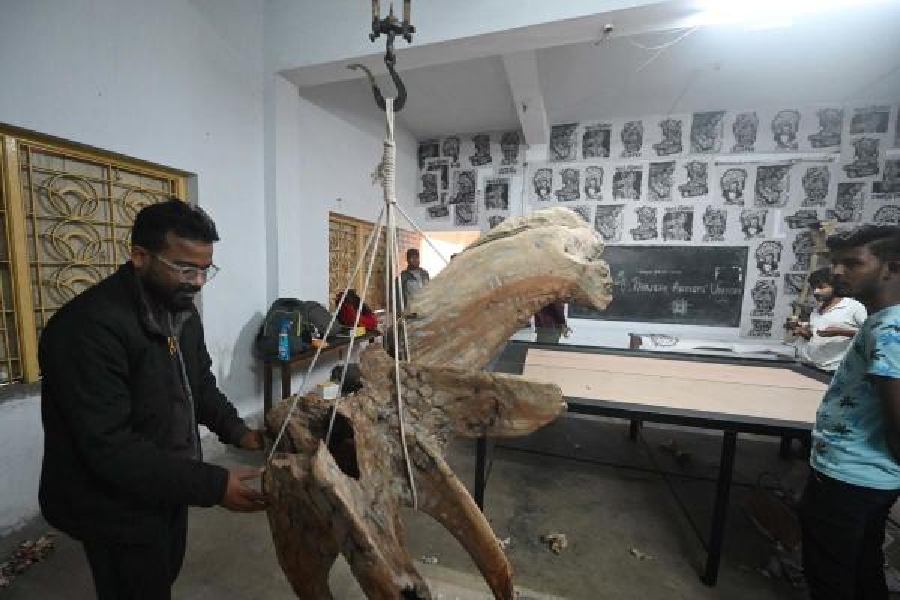The banks of the canal excavated by William Tolly in the late 18th century — convulsed by socio-political tides down the ages and now reduced to a fringe area by a moribund stream — will be the stage for a theatre of resistance that would be played out over four days, beginning Friday.
It will give voice to the margins to talk back through video art, performing art, archived memories and installations of protest.
Paschim Putiary, near Kudghat, is the site for Beyond the Edge, a trial run for a public art exhibition proposed on a biennale model which would revolve around the theme of Erasures and Resistances.
“This is not an art festival or fair which focuses on object-making but a site for the production of meaning and knowledge, and orbits around research and experimentation. This is a cultural space where exchanges would take place to address issues of the day. We aim to create a cerebral rather than a retinal experience,” said Oindrilla Maity, the curator of the event.
Artists, activists, art collectives and performers from across India and Bengal are hard at work transforming the compound of Putiary Brajamohan Tewary Institution and adjacent spots near the Netaji Metro station.
A wall will be the site for a photographic installation by Ram Rahman from Delhi, featuring a collage of buildings razed across the country since the Gujarat riots in 2002.
Sharmila Samant, a Mumbai-based member of Open Circle collective, has been working in South 24-Parganas and will showcase a field called The Garden of Laments in the school courtyard peppered with white poppy flowers crafted by the district’s Malakar community.
“We plan to auction some of the shola pith flowers to support The Wire, the platform for free journalism that is facing suppression,” said research associate Dipanjan Dey.
Panjeri Artists’ Union from the Petrapole border draws from a community of lower caste boatmen who specialise in rowing in the dark. With little or no documentation of their citizenship status, these settlers from the Banipur-Ashoknagar rehabilitation camp area have been grouping together ever since the citizenship laws were amended in 2019.
“They will be using what they call namokantha, blankets stitched during the Partition, as a document of resistance, decorating it with jhulan dolls. Only in place of dolls depicting Lord Krishna’s birth and dalliances, there will be figures of Prime Minister and bulldozers, crafting a political narrative,” said Oindrilla.
Memories of old settlers will be shared through video recordings.
A protest against assault on nature in their area on Jessore Road where numerous ancient trees are being felled in the name of development has been included in their work, by sculpting the trunk of such a tree.
Also participating is Vinayak Bhattacharya who works in the no-man’s land on the Bangladesh border, where barbed wire fences, checkposts and cough syrup addiction are part of the way of life.
His grassboard relief prints defy studio settings and conventional drawing equipment as he uses tools from local hardware stores to draw subjects inspired by the settings, creating art on the space and of the space.
Kudghat itself will be an important participant, both through its residents like Prasanta Das, who is using his Durga puja organisational experience to facilitate the event and has been named director of the project, and through its own geographical and historical narratives.
The canal bank witnesses a synchronous coexistence of churches, mosques, temples and the Brahma Samaj house.
Home to Anushilan Bhavan, a 19th century shelter for Anushilan Samity freedom fighters, it was also a Naxal hub in the mid-20th century after which it also became a refugee colony for settlers from Bangladesh.
“For over a year, we have been studying the area along the course of Tolly’s Nullah, from Bhowanipore to the Bidyadhari, under the guidance of Indologist Nrisingha Prasad Bhaduri. Oral histories are being recorded and a book has been planned. Madhuja Mukherjee has made a documentary film on Tolly’s Nullah. The documents at Anushilan Bhavan will also be digitised,” said Dipanjan.
Two ticketed plays will be staged on January 15, the last day, at Uttam Mancha. Panihati Patrak, an activist group from Sodepur, has adapted Tasher Desh while Birati Samuha will reread The Mahabharata from the point of view of Hidimba, whom Bhim married, thus handing the Pandavas the control of the forest she presided over, drawing a parallel with the exploitation of forest resources by the state in current times.
“We are hoping to create a disruption of settled practices and generate a new level of spectatorship, away from Durga puja installations which is the only form of contemporary art that the city is exposed to,” Oindrilla summed up.
